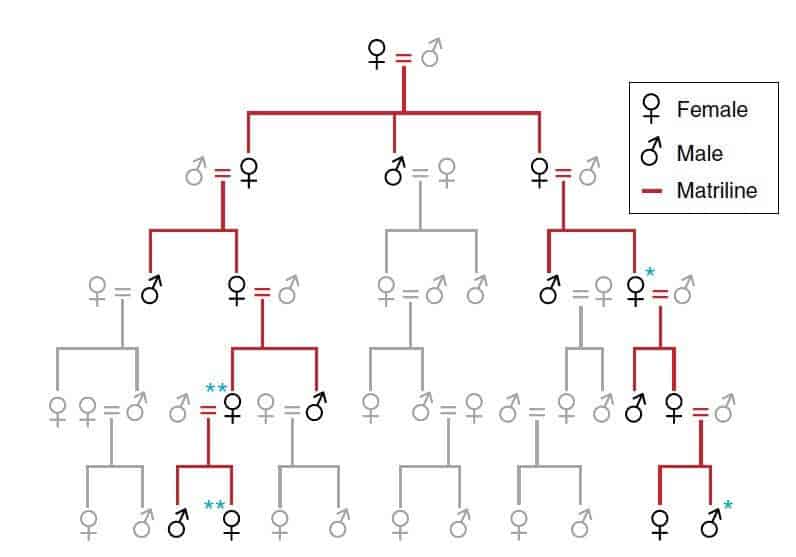
Scientists analyzed DNA sampled from human remains discovered deep in a crypt at the Ancestral Puebloan site of Chaco Canyon. The lavishness of the crypt, which was found right at the center of an ancient 650-room estate, suggests the people buried there formed the elite of the Chaco culture, a civilization that dominated the southwestern United States from the mid-9th to early 13th centuries. Surprisingly, however, the DNA analysis suggests the ancient Chaco were ruled by women who formed a matrilineal dynasty.
Chaco Culture is an umbrella term used to describe the network of sites discovered in northwestern New Mexico where outstanding elements of a vast pre-Columbian cultural complex can be found. These sites were a focus for ceremonies, trade, and political activity and they are remarkable for their monumental public and ceremonial buildings and distinctive multi-storey “great houses.”
One such great house called Pueblo Bonito was discovered by archaeologists in 1896 who were stunned by its complexity and hundreds of rooms. In the middle of this massive house lied a crypt which housed the remains of 14 individuals, accompanied by gorgeous artifacts. These include necklaces, bracelets, and other kinds of jewelry made from thousands of turquoise and shell beads, as well as bones. Clearly, these people were from the Chaco upper hierarchy.
“It has been clear for some time that these were venerated individuals, based on the exceptional treatment they received in the afterlife – most Chacoans were buried outside of the settlement and never with such high quantities of exotic goods,” said, Adam Watson from the American Museum of Natural History who is also one of the lead authors of the new study published in Nature Communications.
Researchers from the American Museum of Natural History (AMNH) in New York City, where the Chaco remains have been stored ever since the excavations ended, wanted to know what was the genetic relationship between these individuals.

One of the initial burials was that of a male in his 40s who died violently following a blow to the head. His is the richest tomb ever found in the American Southwest, adorned with more than 11,000 turquoise beads, many abalone shells, and even a conch shell trumpet which must have come from the Pacific Ocean and the Gulf of California. Above this initial interment, another male was buried. A split plank floor placed above these two graves separated them from another 12 burials. These burials took place over the span of 300 years.
Watson and colleagues analyzed the ancient DNA from nine of these individuals and found they all shared the same mitochondrial genome sequence. Mitochondrial DNA (mtDNA) is inherited only from the mother’s side, so matching mtDNA indicates that not only were all the individuals from the same family, but the inheritance was matrilineal.

The researchers also sequenced nuclear DNA, inherited from both mother and father, from six of the individuals. This analysis revealed more intimate details. For instance, at least two pairs of individuals were very closely related, possibly a mother-daughter or grandmother-grandson.
“First we thought this could be some kind of contamination problem,” said Douglas J. Kennett, head and professor of anthropology, Penn State, who is one of the authors of the study. “We checked for contamination, but found no evidence for it and David Reich’s laboratory at Harvard Medical School corroborated our results.”
The social and civil construct of the Chacho civilization has always been a matter of debate among scholars. Some claim this was an egalitarian society where no ruler was in charge while others suggested Chaco was a state-level society or kingdom with a clear chain of command. These latest findings seem to add weight to the latter hypothesis. Moreover, Chaco seems to have been a hierarchically organized society ruled by women which is pretty rare seeing how most civilizations in history have been patriarchal.
“For the first time, we’re saying that one kinship group controlled Pueblo Bonito for more than 300 years,” said Steve Plog, the David A. Harrison Professor of Archaeology, University of Virginia, who was responsible for radiocarbon dating the Chaco remains. “This is the best evidence of a social hierarchy in the ancient Southwest.”
While the present work fantastically proves that ancient DNA sequencing can output very valuable archaeological and cultural evidence, some voices have criticized the manner in which it was carried. Speaking to Scientific American, Rebecca Tsosie, a law professor of Native American descent at the University of Arizona, said the team did not act ethically.
“I am dismayed that there was not an effort to engage contemporary tribal leaders prior to undertaking and publishing this study,” she said.
George Perry, an ancient DNA expert at Penn State and author of the new paper, confirms the team did not formally consult with tribal leaders. However, he said he is personally “working diligently to engage with multiple groups in the Southwest” and hopes to receive “blessings” for further investigations. One future project might involve sequencing the DNA of Chacoan ancestors to see if there’s any relation to the ancient ruling Chaco lineage.


